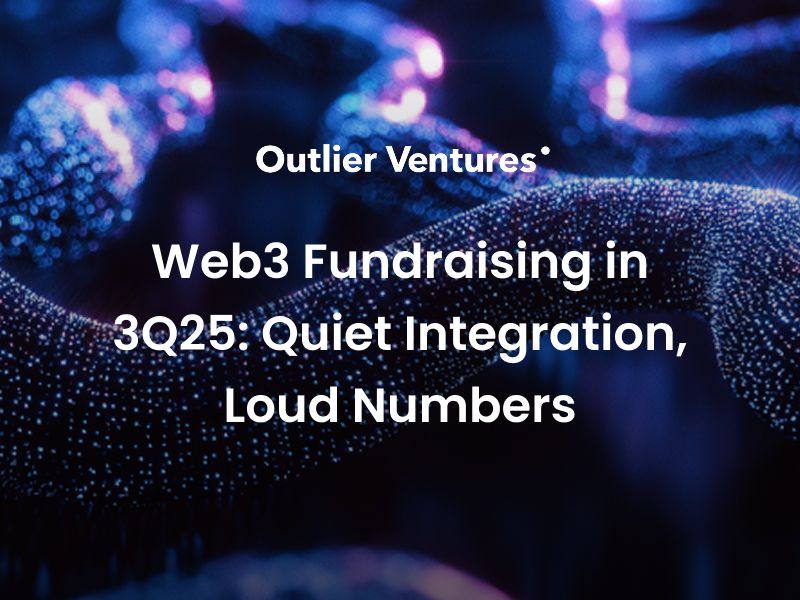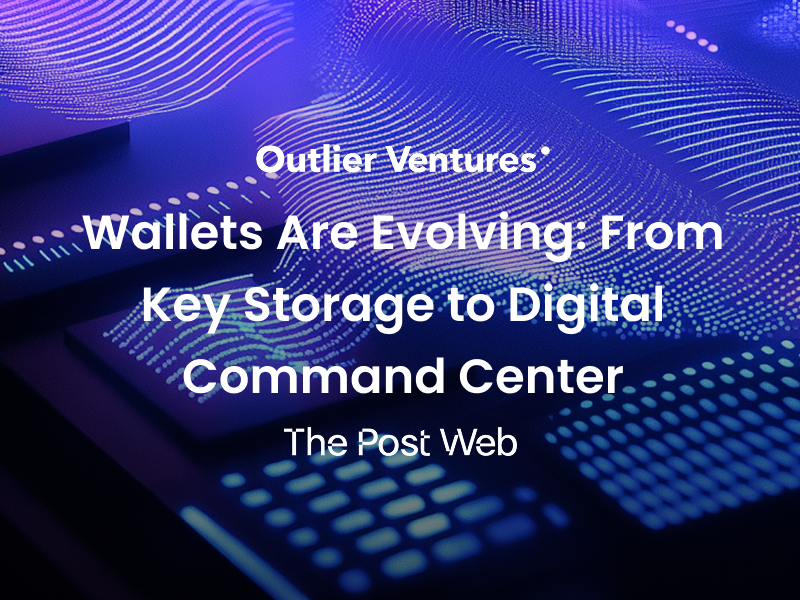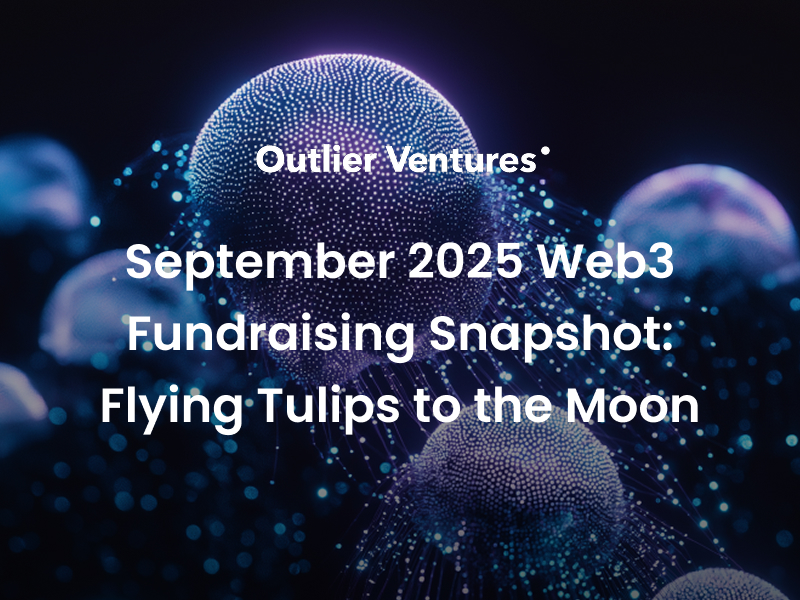Author: Robert Osborne | X | LinkedIn | Substack
TL;DR
- Web3 venture funding surged to $9.6bn, the second-highest quarter on record, even as deal count fell to just 306 disclosed rounds.
- Capital concentration intensified. With fewer companies raising more, median round sizes rose across all stages. Series A hit $17.6m: its highest in over two years.
- Seed rebounded. Median seed round size jumped to $6.6m, reversing Q1’s drop and signalling stronger early-stage conviction.
- Private token sales held steady, raising $410m across just 15 deals. Public token sales collapsed, down 83% in value, with only $134m raised across 35 events.
- Infrastructure continued to dominate, with Cryptocurrency, Mining & Validation, and Compute Networks leading on both capital and investor interest.
- Consumer categories saw flickers of life, especially in Financial Services and Marketplaces, but round sizes and deal share remained relatively modest.
- The quarter reinforced a key lesson from 1Q25: this is no longer a game of coverage. It’s conviction all the way down.
Market Overview: Capital Concentration in Web3 Fundraising
At first glance, the numbers seem contradictory: total Web3 venture capital surged, yet deal count fell sharply. But in the context of the broader recalibration we’ve tracked since 2024, the logic becomes clear: investors are shifting from broad exposure to deeper, more strategic bets. As seen in 2024 in Review, the fundraising engine has been gradually moving away from broad exposure toward deeper, more strategic bets. 2Q25 solidified that transition.
Figure 1: Web3 Deal Count and Capital Fundraised by Quarter, 1Q18 to 2Q25. Source: Outlier Ventures, Messari.
Just 306 disclosed deals (deals whose fundraising details were published) were recorded this quarter: the lowest since mid-2023. But funding soared to nearly $10 billion, nearly 30% higher than last quarter, despite the absence of any Binance-sized outlier. Instead of single megadeals skewing the data, we saw a dense constellation of $50m–$250m raises concentrated in strategic sectors, such as rollup infra, validator liquidity, and token-enabled compute. This is what capital discipline looks like in Web3: fewer bets, bigger rounds, higher bars.
The result is a market that feels both smaller and more serious. In the post-megafund environment, investors aren’t chasing every pitch deck, they’re triangulating narratives, protocol dependencies, and distribution edges. You don’t get funded for being promising. You get funded for being necessary.
Deal Stages in Web3 Startup Funding: Series A Returns
After a year of being ignored, Series A came back into focus.
The median Series A round size climbed to $17.6 million, the highest since early 2022, with 27 deals capturing $420 million in total. These are no longer “proto-B” rounds masquerading as A’s; they’re deliberate allocations to companies with proven product-market fit, revenue traction, and increasingly, integrated token models. They’re precise, deliberate allocations to companies with strong PMF, growing revenues, and, increasingly, embedded token mechanics.
Figure 2: Change in the median round size in pre-seed, seed and Series A stages, by quarter 1Q21 to 2Q25. Source: Outlier Ventures, Messari.
Seed deals also bounced back. Following a dip in 1Q25, median seed round size rose to $6.6 million, while total deal count ticked up modestly. This suggests that investor appetite for early-stage risk is returning somewhat, at least in high-conviction sectors like AI-native infra or validator tooling. Meanwhile, pre-seed held steady at $2.35 million median, confirming what we’ve seen throughout the past year: the idea-stage is still alive, as long as it’s disciplined.
This stage-level distribution suggests a soft reopening of the full venture funnel. 2024 saw capital clustered at the ends, pre-seed optimism on one side, Series B+ maturity on the other. Series A was where conviction went to die. But as noted in Everything You Know About Web3 Fundraising Is Wrong, venture markets don’t stay frozen forever. Infrastructure takes time to build. Eventually, someone needs to scale. In 2Q25, that time came.
Infrastructure Investment Dominates Web3 Capital Flows
The capital-weighted map of Web3 categories this quarter reads like a blueprint for the post-consumer pivot.
Figure 3: Average Stage and Round Size by Category in 1Q25. Source: Outlier Ventures, Messari. Note: “Investor deals” refers to the total number of investor participations in a given category, not unique investors. If one investor participated in three fundraises, that counts as three investor deals.
The biggest round sizes were recorded in Cryptocurrency infrastructure ($112m median), Mining & Validation ($83m), and Compute Networks ($70m). These aren’t speculative tokens. They are the underlying infrastructure powering validator networks, modular blockspace, and AI-aligned consensus systems — the kind of foundational layers that define long-term blockchain investment strategies. Investor logic here is clear: back the rails, then ride the apps.
Other standout infra sectors included Consumer Infrastructure ($11.7m median) and Investment Management ($83m). As observed in previous quarters, these categories sit at the nexus of infra and UX, high-functionality products with technical depth and long-range composability. They’re precisely where the “infra-for-consumer” thesis finds traction.
On the other hand, developer tooling once again attracted strong interest (91 investor deals) but small cheques. It’s a familiar story for this long-tail, low-capex sector. It remains the playground of early teams and protocol-aligned investors willing to play the grant/token optionality game.
Consumer categories showed limited strength. Financial Services, Entertainment, and Marketplaces all posted healthy deal counts and modest median round sizes ($6–18m range), suggesting steady (if cautious) investor attention. But the volume was nowhere near 2021–22 levels. As we explored in Everything You Know, consumer apps have not lost investor interest, they’ve just lost automatic privilege. In 2025, they must now earn their way back.
Token Fundraising in Q2 2025: Private vs Public Sales
After the fireworks of 1Q25, token fundraising in Q2 entered a quieter phase, but the shift was more of a redistribution than a retreat.
Figure 4: Comparison of Private and Public Token Sales by Capital Raised and Deal Count from 2022 to 2024. Source: Outlier Ventures, Messari.
Private token sales raised $410 million across only 15 deals, with a median round size of $29.3 million, the highest since 2021. This surge in high-value private allocations underscores the current Web3 funding climate: alignment and strategic partnerships matter more than retail hype. These weren’t hype-driven memecoins or utility tokens masquerading as protocols. These were serious allocations: validator alignments, L2 treasuries, and modular rollup ecosystems quietly shoring up liquidity.
Public token sales, by contrast, collapsed. Just 35 raises closed, compared to 112 in 1Q25, for a total of $134 million. Median raise size halved. Even retail-friendly launches struggled to attract attention, with most volume concentrated in a handful of high-brand projects. Outside of those, sentiment felt more muted than bearish, a wait-and-see posture rather than full retreat.
The divergence between private and public sales continues the trend we’ve tracked since late 2023. Public token launches spike when the market is hot. But private rounds reflect alignment, not hype. And right now, alignment is everything.
Recruiting: The Post Web Accelerator
If there’s one takeaway from this quarter’s data, it’s this: early-stage funding hasn’t disappeared — it’s evolved. Investors are looking for sharper narratives, stronger foundations, and builders who understand how to navigate this new fundraising landscape.
That’s exactly what we support in The Post Web Accelerator.
Whether you’re refining your token model, building at the intersection of AI and decentralization, or laying the groundwork for user-owned infrastructure — we help early teams turn conviction into traction.
Applications are open now.
Final Thoughts on 2Q25 Web3 Fundraising: The Calm, the Cold, the Clarity
If 2024 was the year of recovery and reshuffling, then 2Q25 feels like the year of quiet execution.
Capital is flowing but only to the few. Deal flow is down but round sizes are up. Infra keeps winning but not out of bias. There’s no great ideological shift underway.
For founders, the path is narrower, but no less viable. Early-stage deals are still happening. Series A is back. And private tokens have a real seat at the table again, as long as they align with something strategic, scalable, and protocol-dependent.
In short: we’ve left the market-wide hype cycle. We’re now somewhere between hydraulics and headwinds. A slow, pressurised climb toward infrastructure that matters and applications that last.
The takeaway is simple: this market doesn’t need more hype cycles, it needs inevitability. In 2Q25, Web3 venture capital rewarded strategic positioning, robust infrastructure plays, and token models with clear network effects. The winners were those aligned with long-term value creation.





